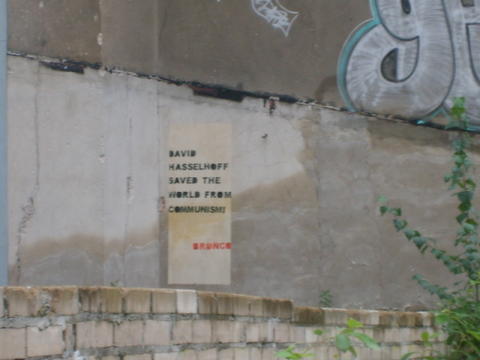
September 29, 2007
April 13, 2007
I’m back and ‘Stasiland’: a review
I got back to Leicester this afternoon and immediately set to work. No, not really – my brain is still very much elsewhere. This is where blogging comes in. I find it a really useful way of getting back in ‘the swing of things’.
While I was away, I abandoned the other books I’d been reading and settled down with my second-hand copy of Anna Funder’s Stasiland: Stories From Behind the Berlin Wall, as recommended to me by Mary. It was great – obviously it’s a personal account/reflection on post-1989 Berlin and the fall of communism, but – as it’s based around a series of personal testimonies recorded by Funder in interviews with Stasi victims and operatives alike – it offers a good introduction to the subject from a ‘human’ perspective. Funder’s writing style is warm and engaging, and the stories she presents equally moving and disturbing.
I want to single out a few points which correspond with my research. In particular Funder’s personal reflections on the various museums/memorials related to the Berlin Wall, communist Germany and the Stasi , and their visitors, are richly descriptive and considered, reflecting my thoughts that – to a large extent – the memorialising of locations, such as the Stasi HQ, serve to contain the memories, experiences and power associated with the old regime. But they also lend an authenticity to the documents and artefacts to the objects housed within them, something which visitors clearly value. In a particularly illuminating passage Funder contrasts the brand new, but soulness – and, more crucially – sparsely visited (at least in her telling) Contemporary History Forum in Leipzig, with the ‘real deal’, the Runde Ecke (the Stasi HQ in Leipzig). (Incidentally, in her comment on my post about communist relics, Mary picked out a telling passage from this section of the book.) In addition, there is a suggestion that the museumfication process heralds the death-knell of the ideology of the regime. Miriam, a correspondent of Funder’s who ‘haunts’ the narrative throughout, expresses great satisfaction at the conversion of the Runde Ecke into a museum. For her it represents a triumph over the regime (p. 46). The survival of such sites – though much contested, by various ‘interest groups’ in the former GDR – into post-communist Berlin and Germany are clearly vitally important to several committed ‘activists’, whom are simply not prepared to allow the unified nation of Germany to forget what happened in the GDR.
Finally, Funder documents the ostalgie for and tourist kitsch related to the Berlin Wall. She describes hawkers of spurious relics: ‘genuine’ pieces of the wall, communist memorabilia and cheap GDR-themed souvenirs, who continue to peddle their wares despite the increasing ‘sanitisation’ of communist Germany, represented most iconically by the Berlin Wall, of which very little now remains in situ.
Overall, the impression one gets from Funder is of a country – for many residents (or at least those interviewed by Funder) still appear to consider themselves as Other from the ‘Wessis’ – struggling to find the best way of dealing with the legacy of communism and negotiating Kapitalismus. It’s a great read, which – I’m sure – will continue to resonate with me for some time.